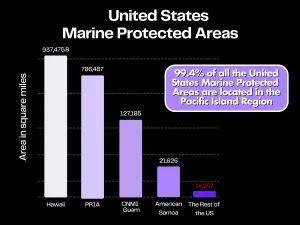
Dear Editor,
The federal government’s proposal to convert the Pacific Remote Islands Area Marine National Monument (PRIMNM) to a National Marine Sanctuary poses a significant threat to the economic stability of American Samoa. This conversion, which would implement an expansion of the “no-take” zone from 50 to 200 nautical miles, could cripple our tuna industry, the backbone of the economy here in American Samoa.
I have three major issues with this proposed designation of National Marine Sanctuary for the PRIMNM. First of all, the proposed sanctuary designation would prohibit commercial fishing within its boundaries, jeopardizing the supply of tuna to the American Samoa cannery. This cannery is not only our major employer, but also contributes significantly to supporting basic infrastructure costs in the territory.
The American Samoa Department of Commerce has estimated that due to the presence of the cannery and the high volume of shipping, coupled with the fact that they are the territory’s largest consumer of generated power and fuel, that they subsidize about 40% of our costs for power, fuel and shipping. The potential loss of the cannery and the jobs they support both directly and indirectly would create an economic ripple effect which would likely devastate our local economy. Very few businesses, especially small, locally-owned ones would be able to survive the cost of shipping, ASPA bills and fuel costs going up by 40%.
Secondly, the science behind the proposed expansion, specifically the reliance on arbitrary distance measures and limited data samples, is questionable. Recent studies
have shown that large-scale “no-take” zones in blue water offer limited benefits compared to other more flexible management tools. Furthermore, tuna are migratory, making marine protected areas (MPAs) less effective, especially in the face of climate change. Imagine drawing boxes in the sky and telling duck hunters not to shoot ducks when they are in those boxes and thinking it will have any positive conservation effect on the duck population. No, the answer is to address the hunters that are taking more than they should, or who do so in areas that hunting is not allowed, or doing so without permits.
If the goal is truly to do this, don’t add extra layers of regulatory red tape on our US fishermen who already follow the rules and participate in the most highly regulated and monitored fishery in the world. Recent studies show that displacing fishing effort with MPAs can actually have negative impacts on stocks and fisheries as fishing effort is concentrated in remaining open areas, potentially leading to increased fishing pressure and negative consequences for tuna populations in those areas. As the effects of climate change become more evident, there’s also the potential for tuna populations to shift their distribution.
Should the tuna populations shift into the PRIA and it is closed to commercial fishing, it could spell disastrous results for American Samoa. The key is to address the bad actors like China who have a fleet which is highly subsidized by the Chinese government. Their vessels consistently ignore management and conservation measures in our region. According to firsthand accounts of our local longline and alia fishermen, there are already Chinese fishing vessels illegally fishing in our American Samoa Exclusive Economic Zone (EEZ). Unfortunately, the federal government has not allocated a US Coast Guard asset to patrol our waters, despite recommendations from the local government and Western Pacific Regional Fishery Management Council (WPRFMC) for them to do so. Not only does this cripple our ability to enforce illegal, unreported and unregulated (IUU) fishing in our waters, it is a huge safety issue.
If a boat is in distress at sea or there’s another at sea emergency, we have to rely on the New Zealand government’s Coast Guard to travel 2,000 miles to be our first responders on the ocean. For a government that sends billions of dollars of aid to foreign countries (which is not all bad) to ignore its own people and a huge need for their security and safety, that is just unacceptable. Getting back to the science of the issue, three recent studies all suggest that there are limited benefits to large scale blue water no-take MPAs compared to other more flexible management tools (Hampton et al. 2023; Hilborn et al. 2022; Pons et al. 2022). MPAs can be a great tool for coastal and nearshore areas with coral reefs if utilized properly, but there are no coral reefs 200 nautical miles out to sea and so in this instance they are not effective.
Just recently, the Phoenix Island Protected Area – which is right next to the PRIMNM area – was closed down after the closed area did not provide the benefits to tuna stock that had been intended. Even according to the federal government’s own laws, namely the Magnuson-Stevens Fishery Conservation and Management Act (MSA), this sanctuary expansion does not make sense. National Standard 1 under the MSA states that conservation and management measures shall prevent overfishing while achieving, on a continuing basis, the optimum yield from each fishery for the United States fishing industry. The tuna stocks in the Pacific Remote Island Area waters are not overfished or experiencing overfishing according to NOAA’s own stock assessments. National Standard 4 states that conservation and management measures shall not discriminate between residents and shall be fair and equitable to all fishermen.
Over 99% of all the nation’s Marine National Monuments are located in the Pacific Islands. This is the exact opposite of equitable, and that brings me to my final point.
The current administration implemented a policy of Equity and Environmental Justice (EEJ) to prioritize identification, equitable treatment, and meaningful involvement of
underserved communities. How the federal government has made the people of the Pacific Islands carry all the water for their mandate of 30×30 (the initiative for the US to achieve protection of 30% of its lands and waters by 2030) is disgusting and inexcusable, especially considering its own EEJ policy. They want to create a sanctuary and close three quarters of a million square miles of ocean to our US fishermen, putting our cannery and our way of life in American Samoa in jeopardy. What do you think would happen if the government tried to close that size of ocean in New England waters to lobster fishermen? Or how about in Alaska for crab and pollock fishermen? But we are US nationals, not citizens.
We have a delegate to Congress who is not allowed to have a vote. So we are expected to do the heavy lifting for the federal government for its dreams of conservation, even if the result is the collapse of our economy. Think about how these monuments were designated in the first place.  Presidents using the Antiquities Act to shoehorn in these huge areas of closed ocean. Bypassing Congressional approval, bypassing any input from the people of American Samoa and the other Pacific Islands in the process. The one silver lining was that these designations could be undone just as easily as they were implemented by another president.
Presidents using the Antiquities Act to shoehorn in these huge areas of closed ocean. Bypassing Congressional approval, bypassing any input from the people of American Samoa and the other Pacific Islands in the process. The one silver lining was that these designations could be undone just as easily as they were implemented by another president.
So what does the federal government do? They planned to designate Sanctuaries over the Monuments to cement them in place, making them much harder to remove. This bypassing of any economic and social impact assessment to build presidential legacies, is not equitable, and it certainly doesn’t provide environmental justice for our people in American Samoa. Here is a stark reminder of how little our input as Samoans seems to matter to this federal government, our Governor and Lieutenant Governor, our Fono, our Congresswoman, the heads of our local environmental agencies and the overwhelming majority of our residents have voiced their disapproval for this proposed sanctuary designation. Yet, this has not dissuaded the federal government from moving forward with the plan in the PRIMNM. No equity. No justice. No voice.
I don’t blame our local National Marine Sanctuary of American Samoa, in fact Superintendent Atuatasi Lelei Peau is my mentor and the person I credit most in my professional journey. We may not agree on everything, but I highly respect him and know he is a great man. The blame for this situation falls on the leadership of our federal government. The proposed National Marine Sanctuary in the Pacific Remote Islands represents a classic case of well-intentioned conservation efforts potentially leading to unintended and devastating consequences for a vulnerable community. Yet, when confronted by all the backlash, the government does not change course, it plows forward. It is crucial that the federal government prioritizes genuine engagement with American Samoa and our people who live here and depend on the tuna industry for our way of life. Ignoring the concerns of American Samoa would not only be ethically wrong, but also economically shortsighted.
Sincerely,
Nate Ilaoa
Concerned Resident




